Related Research Articles
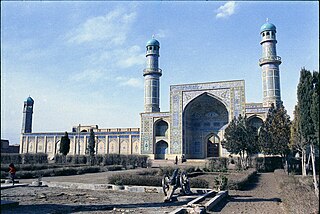
Herāt is an oasis city and the third-largest city in Afghanistan. In 2020, it had an estimated population of 574,276, and serves as the capital of Herat Province, situated south of the Paropamisus Mountains in the fertile valley of the Hari River in the western part of the country. An ancient civilization on the Silk Road between West Asia, Central Asia, and South Asia, it serves as a regional hub in the country's west.

Ghazni, historically known as Ghaznayn (غزنين) or Ghazna (غزنه), also transliterated as Ghuznee, and anciently known as Alexandria in Opiana, is a city in southeastern Afghanistan with a population of around 190,000 people. The city is strategically located along Highway 1, which has served as the main road between Kabul and Kandahar for thousands of years. Situated on a plateau at 2,219 metres (7,280 ft) above sea level, the city is 150 kilometres (93 mi) south of Kabul and is the capital of Ghazni Province. The name Ghazni drives from the Persian word "ganj", meaning ‘treasure’.

Ghazni is one of the 34 provinces of Afghanistan, located in southeastern Afghanistan. The province contains 19 districts, encompassing over a thousand villages and roughly 1.3 million people, making it the 5th most populous province. The city of Ghazni serves as the capital. It lies on the important Kabul–Kandahar Highway, and has historically functioned as an important trade center. The Ghazni Airport is located next to the city of Ghazni and provides limited domestic flights to Afghanistan's capital, Kabul.
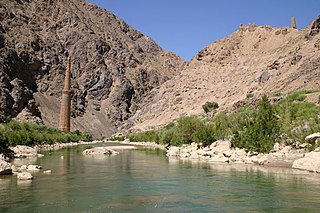
Ghōr, also spelled Ghowr or Ghur, is one of the thirty-four provinces of Afghanistan. It is located in the western Hindu Kush in central Afghanistan, towards the northwest. The province contains eleven districts, encompassing hundreds of villages, and approximately 764,472 settled people. Firuzkoh is the capital of the province.

Abu al-Qasim Mahmud ibn Sabuktigin, usually known as Mahmud of Ghazni or Mahmud Ghaznavi, was Sultan of the Ghaznavid Empire, ruling from 998 to 1030. During his reign and in medieval sources, he is usually known by his honorific Yamin al-Dawla. At the time of his death, his kingdom had been transformed into an extensive military empire, which extended from northwestern Iran proper to the Punjab in the Indian subcontinent, Khwarazm in Transoxiana, and Makran.

The National Museum of Afghanistan is a two-story building located across the street from the Darul Aman Palace in the Darulaman area of Kabul, Afghanistan. It was once considered to be one of the world's finest museums. There have been reports about expanding the museum or building a new larger one.
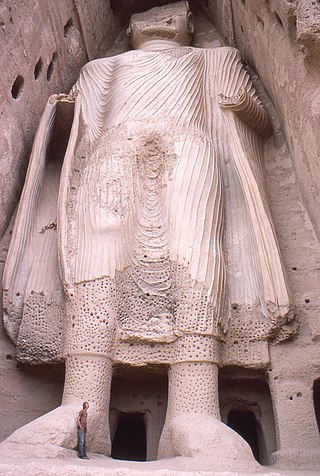
Buddhism, a religion founded by Gautama Buddha, first arrived in modern-day Afghanistan through the conquests of Ashoka, the third emperor of the Maurya Empire. Among the earliest notable sites of Buddhist influence in the country is a bilingual mountainside inscription in Greek and Aramaic that dates back to 260 BCE and was found on the rocky outcrop of Chil Zena near Kandahar.

Nawur is one of the districts of Afghanistan, which is located in the northern part of Ghazni Province. With an area of approximately 5,234 km2 (2,021 sq mi), Nawur is the largest district of Ghazni province. Its population was estimated at 91,778 in 2002. Nawur's inhabitants are ethnic Hazaras followed by Kochis. The Jikhai River originates here.
Nawa is a large district in the far south of Ghazni Province, Afghanistan. It is 100 km south from Ghazni in a mountainous region. The salt lake Ab-i Istada is located in the northern part of the district. Nawa's population was estimated at 29,054 in 2002, of whom around 45% were children under 12. The district center is the village of Nawa. Military operations in the district were featured in articles in the Washington Post and the New York Times in October 2009. The district was controlled by the Taliban until 17 July 2017.
Museum of Islamic Art may refer to:

Rome's National Museum of Oriental Art "Giuseppe Tucci" was a museum in Rome, Italy, that was dedicated to the arts of the Orient, from the Middle East to Japan. The museum was located in Via Merulana 248 in the Rione Esquilino.

Andar is one of the eastern districts of Ghazni Province in Afghanistan. The population has been estimated at 88,300, all Pashtun. The district center is Miray while the other main town is Andar. The district is named after the Andar Ghilji tribe of the Pashtuns. The district also contains the town of Sardeh Band on its edge near the border with Paktika Province.

Shahjoy District is a district of Zabul province in southern Afghanistan. It is located in the eastern part of the province, next to Ghazni province.
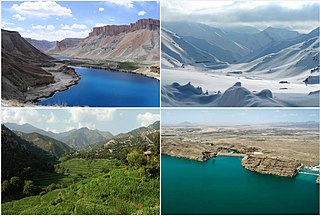
Tourism in Afghanistan is regulated by the Ministry of Information and Culture. There are at least 350 tourism companies operating in Afghanistan. Tourism was at its peak before the 1978 Saur Revolution, which was followed by the decades of warfare. Between 2013 and 2016, Afghan embassies issued between 15,000 and 20,000 tourist visas annually. Following Taliban's return to power in August 2021, visitor numbers gradually increased from 691 in 2021 to 2,300 in 2022, reaching 7,000 in 2023.

Ghazni Airport is located in Ghazni, Afghanistan, next to the main Ghazni-Kandahar Highway. It serves the population of Ghazni and other nearby Afghan provinces. The airport is mainly used for civilian flights and is still being developed as of late 2013.

Afghan art has spanned many centuries. In contrast to its independence and isolation in recent centuries, ancient and medieval Afghanistan spent long periods as part of large empires, which mostly also included parts of modern Pakistan and north India, as well as Iran. Afghan cities were often sometimes among the capitals or main cities of these, as with the Kushan Empire, and later the Mughal Empire. In addition some routes of the Silk Road to and from China pass through Afghanistan, bringing influences from both the east and west.
Afghanistan is uniquely situated as a throughway of cultures throughout its history due to it geographic placement in South Asia. Afghanistan's location lends porous borders to trade routes between the East and West, while the Silk Road providing a vector for Buddhism and Hellenistic culture and even Egyptian influences from the west, renders an amalgamation of culture and art. Perpetual invasion and conflict has rendered a cyclic continuum of renaissance and destruction of art and culture in Afghanistan.

The Sarda Dam is located near the town of Sardeh Band, in the eastern part of Andar District of Ghazni Province of Afghanistan. Part of its reservoir, which provides fresh water to much of southern Ghazni, is in neighboring Paktika Province. In recent years, the locals proposed to turn the area into a national park, similar to the Band-e Amir National Park in Bamyan Province.
Sardeh Band or Sardeband is a town located on the eastern edge of Andar District, Ghazni Province, Afghanistan, near the border with Paktika Province. The town is located near the Sardeh Band Dam. The Sardeh Band Airport is located in the town.
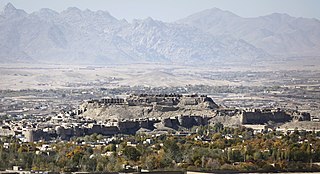
The Citadel of Ghazni is a large medieval fortress located in Ghazni city, east-central Afghanistan. It was built in the 13th century surrounding the Ghazni town to form a walled city. The 45 metre high citadel dominates the skyline.
References
- ↑ "The Museums of Ghazni, Afghanistan". UNESCO . Retrieved 27 December 2011.
- ↑ Myers, Bernard Samuel (1959). Encyclopedia of world art. McGraw-Hill. p. 302. Retrieved 27 December 2011.
